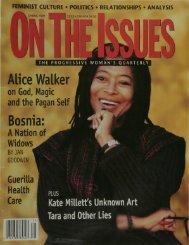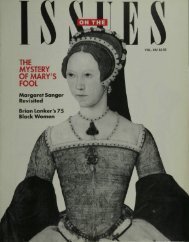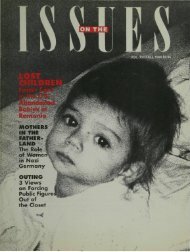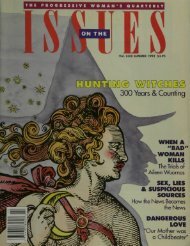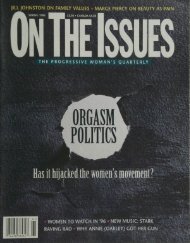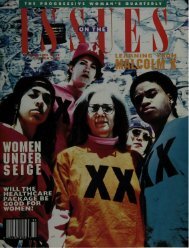view entire issue in pdf format - On The Issues Magazine
view entire issue in pdf format - On The Issues Magazine
view entire issue in pdf format - On The Issues Magazine
You also want an ePaper? Increase the reach of your titles
YUMPU automatically turns print PDFs into web optimized ePapers that Google loves.
packed <strong>in</strong>to under 200 pages. It's even harderto believe that anyone will ever have anyth<strong>in</strong>gto add to the topic. <strong>The</strong> book can beordered from Kendall-Hunt Publish<strong>in</strong>g Co..2460 Kerper Blvd., PO Box 539. Dubuque.Iowa 52004-0539.Choice Books14My first reaction to Are You Still MyMother? Are You Still My Family? by Gloria GussBack (Warner Books. S7.95 paperback) wasdisbelief. Disbelief that so many enlightened,<strong>in</strong>telligent, otherwise liberal parents couldreact so strongly and so negatively to abeloved child tell<strong>in</strong>g them that she or he isgay. <strong>The</strong>refore. I did some <strong>in</strong>vestigat<strong>in</strong>g onmy own. ask<strong>in</strong>g "enlightened, liberal" womenand men how they would react to discover<strong>in</strong>gthat one or more of their children is homosexual.1 rapidly discovered that Ms. Back isabsolutely on target. <strong>The</strong> reactions werestrong—and negative. Each <strong>in</strong>dividual, however,gave a different reason for the negativeresponse. <strong>The</strong> variety of answers were bestsummed up by a physician whom I hadalways considered avant garde <strong>in</strong> his sexualth<strong>in</strong>k<strong>in</strong>g. Yes. he said, he would be upsetbecause "People who share similar th<strong>in</strong>gs aremore drawn together. A non-shar<strong>in</strong>g of avery emotional, personal value is alienat<strong>in</strong>g."Are You Still My Mother? has manyvignettes about parents of gay people, andabout the children themselves. It also gives astep-by-step account of the six-session workshopsfor parents of gays (<strong>in</strong>clud<strong>in</strong>g materialsused) conducted <strong>in</strong> the New York City area byMs. Back, an M.S.W. and herself the motherof a gay son. <strong>The</strong>re is an excellent section onwhat experts, <strong>in</strong>clud<strong>in</strong>g m<strong>in</strong>isters, psychiatrists,social workers, etc.. have to say abouthomosexuality, much of which should be ofgreat help to a parent who is deal<strong>in</strong>g with achild's "com<strong>in</strong>g out." Another very importantsection. "What's A Parent to Do?" discusseshow to best protect your child, politically,philosophically and emotionally <strong>in</strong> a numberof different ways.This book is comprehensive and practical,as well as personal and mov<strong>in</strong>g. I wouldlike to see it used <strong>in</strong> all schools of social work,and I would like to see workshops, such asthose Ms. Back conducts, proliferatethroughout the country. We are all aware ofthe need for support groups, but these workshopsgo far beyond that <strong>The</strong> agenda<strong>in</strong>cludes a historical perspective, philosophies,quizzes and read<strong>in</strong>g materials, designed to<strong>in</strong>crease parental sensitivity and awareness,help<strong>in</strong>g them to come to a realization thatone father expressed: "Most of the gays Ihave met. like my own son. are decent, lawabid<strong>in</strong>ghuman be<strong>in</strong>gs: taxpayers; voters;and, aside from their sexual orientation, nodifferent <strong>in</strong> their desires and needs from thelikes of us. It is an honor to have my son <strong>in</strong>our family, and if 'family' is the strength ofour country. I'll hold m<strong>in</strong>e high up <strong>in</strong> pride."<strong>The</strong> acceptance of his sons homosexualityprobably did not come to this fatherquickly or easily. This is a hard-won messagefrom parent to child that despite "differences"there is family support, unity, trustand love.Whether or not we have gay children,this book gives us a lot to th<strong>in</strong>k about.— Beverly LowyBreak<strong>in</strong>g the Cycle of Child Abuse byChrist<strong>in</strong>e Comstock Herbruck (W<strong>in</strong>ston Press.M<strong>in</strong>neapolis. MN, S4.95. paperback) describesthe work of Parents Anonymous, an organizationdesigned to supply help and support toabusive parents who are try<strong>in</strong>g to break theirpatterns of child abuse. <strong>The</strong> work done by PAis certa<strong>in</strong>ly important. People should be madeaware of its existence and. possibly, set uptheir own chapters with hotl<strong>in</strong>es throughoutthe country. However, this re<strong>view</strong>er hadproblems with the book itself. Too manynames and case histories are thrown at thereader without a follow-up; one never knowsif, or how, the problem of abuse wasresolved. Another problem was the particulargroup highlighted. It seemed to be composedof middle-class women whose abusive patterns,for the most part, were verbal, emotionaland passive rather than physical. Noneof the women (there were few men whoattended) seemed <strong>in</strong> f<strong>in</strong>ancial straits andtheir physical surround<strong>in</strong>gs sounded comfortable.All abusive parents have emotionalproblems, but these women were not subjectedto the external pressures that povertycan br<strong>in</strong>g. <strong>The</strong> book is episodic; one neverfeels <strong>in</strong>volved with the core group of women— <strong>in</strong> fact, it's difficult to keep them straightand to remember who had what abusivecharacteristics.<strong>The</strong> author claims that 90 percent of abusivehomes can be made safe, but she doesn'tdocument this claim; and because there wasvery little case follow-up <strong>in</strong> the book itself, areader has no way of know<strong>in</strong>g how she cameto this conclusion. Nevertheless, the book isvaluable as a discussion of the work done byPA and <strong>in</strong><strong>format</strong>ional on how to set up PAchapters. If the life of only one child is savedbecause a parent went for help. Ms. Herbruckhas done a real service by br<strong>in</strong>g<strong>in</strong>g PA to theattention of the public.Child Pornography by Shirley O'Brien(Kendall-Hunt Publish<strong>in</strong>g Co.. Dubuque. Iowa.S9.95 paperback) is probably the best, mostcomprehensive book we've ever read on thissubject, and it should be read by every parent,teacher, or anyone <strong>in</strong>terested <strong>in</strong> the welfareof children. Dr. O'Brien goes far beyondpornography and sexual abuse. She profilesthe victims, discusses the long-last<strong>in</strong>g effectson the child and why it is so difficult for parentsto deal with an eroticized child; <strong>in</strong>terventionand treatment programs; and how totake action. Protective, preventive measuresare discussed <strong>in</strong>-depth. Most of all, she dealswith a sensational topic <strong>in</strong> an <strong>in</strong>telligent,<strong>in</strong><strong>format</strong>ive, non-exploitive way. It is hard tobelieve that so much <strong>in</strong><strong>format</strong>ion can beLillian Wald of Henry Street by Beatrice Siegel(Macmillan Publish<strong>in</strong>g $12.95)It never ceases to amaze me—theamount of women's history that has beensurpressed or just not available when I wasgrow<strong>in</strong>g up and look<strong>in</strong>g for role models. It isof note that as an educated woman and fem<strong>in</strong>istand as an adolescent who attended theHenry Street Settlement Music School. Iknew noth<strong>in</strong>g of Lillian Wald. her life or herwork, until I read this book. That fact alonemakes it important.Lillian Wald is currently considered byscholars one of America's "most significantwomen and one of America's most importantsocial reformers." Beatrice Siegels workbr<strong>in</strong>gs Wald s world, her life and her significanceto women <strong>in</strong> the fem<strong>in</strong>ist and women'shealth movements very much alive.It was that turbulent time of the early20th century on the lower east side—streetsteem<strong>in</strong>g with immigrants, radicals, <strong>in</strong>tellectualsand reformers. Wald was not an immigrantbut came from an affluent Jewishfamily. As a medical missionary, she used hersocial and political connections to impactstrongly on the labor movements, peacemovements, reforms for women and childrenand —her greatest achievement—<strong>The</strong> HenryStreet Nurses' Settlement, on New York'slower east side.Historically and politically, this book isextraord<strong>in</strong>ary for the rem<strong>in</strong>der that the secondwave of fem<strong>in</strong>ism is almost repetitive ofthe first. Wald fought for city money to fightthe problems of <strong>in</strong>fant mortality. What wasthe po<strong>in</strong>t of help<strong>in</strong>g <strong>in</strong> the birth of a child ifshe did not help it grow? She fought aga<strong>in</strong>stchild labor and abuse, work<strong>in</strong>g with thefamous Mother Jones and Jane Addams.Wald envisioned a national researchcenter. "Ours is the only great nation whichdoes not know how many die each yearwith<strong>in</strong> its borders ". She arranged the firsthear<strong>in</strong>gs on the Care of Dependent Childrenand was ma<strong>in</strong>ly responsible for the FederalChildren's Bureau. She was one of the firstfounders of the Women's Trade Union. <strong>The</strong>irplatform <strong>in</strong>cluded demands for equal pay forequal work, eight hour work days and women'ssuffrage. N<strong>in</strong>ety years later, one of herdemands still has to become a reality.Backed <strong>in</strong> large part by the wealthyf<strong>in</strong>ancier, Jacob Schiff. Wald founded theHenry Street Settlement and there lived witha group of <strong>in</strong>tellectual, committed, educated,middle class, unmarried women. Wald's ownmiddle-class background oriented her alwaystowards the realization that life was notpurely survival but must <strong>in</strong>corporate somemeasure of joy—not only bread but rosestoo!As for Lillian Wald. the woman—forme she rema<strong>in</strong>ed throughout this book, oddlyelusive. I had the strange impression that Iwas. at times, read<strong>in</strong>g an extended resume.Wald is presented only by her accomplishmentsand ma<strong>in</strong>ly through the eyes of hercontemporaries. I never got to know how shedealt with the difficulties of be<strong>in</strong>g out ofstep and out of class, or of be<strong>in</strong>g a pioneer. In1915. Jane Addams wrote to Wald that "Youare a pioneer, as you know and must live up




